Tissues of the Body - Anatomy and Physiology
Tissue - a group or mass of similar cells working together to perform commun functions
There are 4 major types of tissue :
1. Epithelial Tissue
General Characteristics:
- Found throughout the body, covers all body surfaces both inside and out.
- Main glandular tissue.
- Attached to underlying connective tissue at the basement membrane
- Usually has no vascular tissue - blood supply
- Cells reproduce rapidly results in: rapid healing
Functions: Protection, secretion, absorption, excretion, sensory perception
categorized based on the shape of the cells and the layer sof cells.
A. SIMPLE SQUAMOUS -
Form: flat and thin, single layer
Function: diffusion and filtration
Found in: air sacs of lungs, walls of capillaries

B. SIMPLE CUBOIDAL - single layer, cube-shaped cells.
Function: Secretion and absorption
Found: Lining of kidney
tubules, ducts of glands, covering surface of ovaries
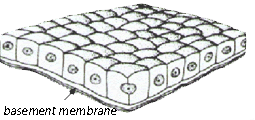
C. SIMPLE COLUMNAR - single layer,
long cells with their
Function:
Secretion and absorption
Found in the
lining of digestive tract and uterus
- contains scattered goblet cells to secrete mucus
- and microvilli increase surface area
Label image:
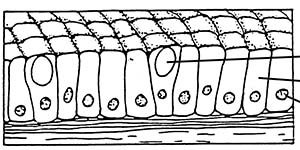
D. STRATIFIED SQUAMOUS - muli-layered, squamous cells
Functions in protection. Found lining body cavities like the skin and mouth

*What is Wrong with Ella's Skin
- mutations in the COL7A1 gene affects the protein collagen
- collagen acts like a "glue" to anchor the epidermis to the dermis|
- as the dermis pulls away, blisters form
- this can also affect the lining of the mouth and esophagus, making it difficult to swallow
E. PSEUDOSTRATIFIED COLUMNAR - appear
"stratified" but really a single layer with nuclei at various levels
giving the appearance of layers.
-Can have cilia (tiny, hair-like projections)
-And goblet cells, which secrete mucus
- Function: secretion and cilia-aided movement
- Location: lining air passages like the trachea and tubes of the reproductive
system
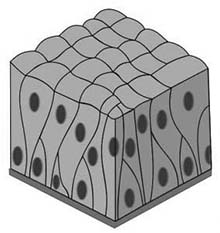
*What happens if the cilia of cells do not work properly? *Reference to a previous case on a child who has primary ciliary dyskinesia, which caused excess mucus and respiratory infections
F. TRANSITIONAL EPITHELIUM - thick,
layered cuboidal cells. "Stretchable" tissue, also forms barrier to
block diffusion.
Found: lining of urinary bladder
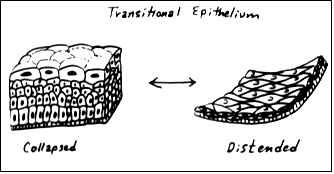
G. Glandular Epithelium
Cells specialized to secrete substances; make up the body's glands
Exocrine - salivary and sweat
Endocrine - hormones
Assignment: What Causes Goosebumps
2. Connective Tissue
General Characteristics:
-Most abundant tissue in your body, found throughout
-Binds structures together
-Provides support, protection, framework, fills space, stores fat, produces
blood cells, fights infection
-Composed of more scattered cells with intercellular matrix
-Made up of a ground substance (fluid, semi-solid) and fibers
-Most has a good blood supply
-Cells can reproduce
Three common types of cells:
1. Mast cells (prevent clots)
2. Macrphages (consumers)
3. Fibroblasts (produce fibers)
Main types of fibers:
-collagenous fibers Strong, flexible; Found: bones, ligaments, tendons
- elastic fibers Found in ears and vocal cords
Color the Matrix of Connective Tissue
CATEGORIES OF CONNECTIVE TISSUE
- LOOSE C.T. or AREOLAR TISSUE - binds skin to underlying organs and organs to organs, forms delicate, thin membranes throughout the body
- ADIPOSE TISSUE - aka FAT ' Function: Protective cushion, insulation to preserve body heat, stores energy, cells are called adipocytes
- FIBROUS C.T. - dense tissue, closely packed, thick collagenous fibers and
fine network of elastic fibers. Few cells, poor blood supply, thus slow healing.
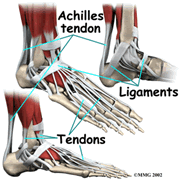
Tendons - connect bone to bone
Ligaments - connect muscle to bone
CARTILAGE (all cartilage cells are called chondrocytes)
HYALINE CARTILAGE - covers ends of joints
ELASTIC CARTILAGE - external ears and larynx
FIBROCARTILAGE - cushions vertebrae
BONE TISSUE - Osseous tissue. Rigid due to mineral salts.
BLOOD TISSUE - circulates throughout the body
3. Muscle Tissue
A. Skeletal - striated, moves the bones
B. Smooth - digestive system
C. Cardiac - heart
4. Nerve Tissue - Found in brain, spinal cord, nerves
A. Neurons - transmit signals
B. Neuroglia - protection, support